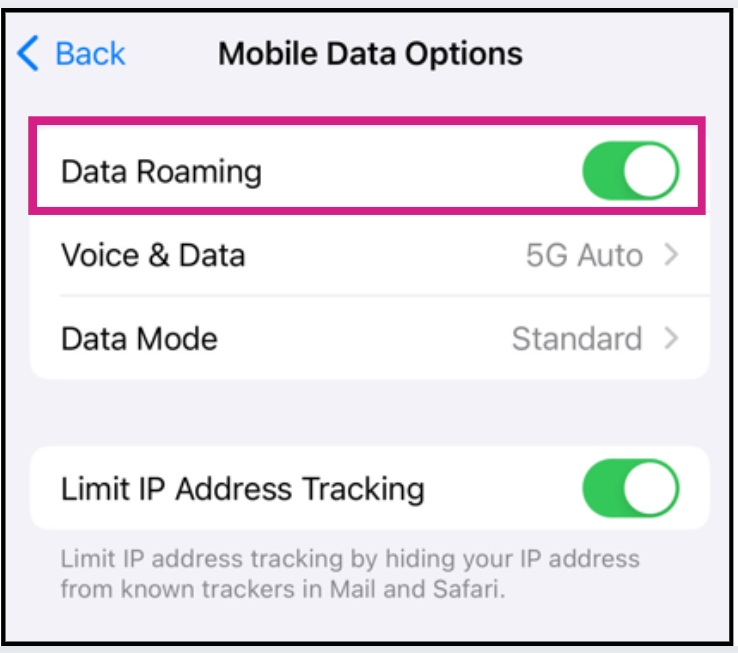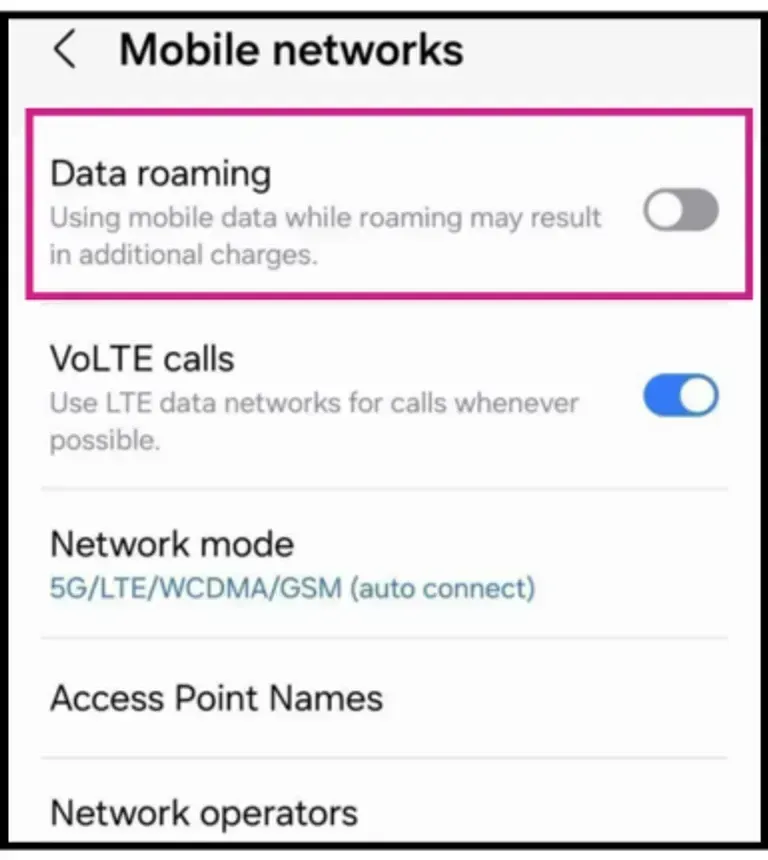Autumn Promo

What Is Data Roaming? How To Manage Data Roaming Costs
In this post...
- What is data roaming?
- What’s the difference between mobile (cellular) data and roaming data?
- Why is data roaming so expensive?
- Do roaming charges work differently for data, calls, and texts?
- 5 ways to avoid roaming charges
- Do background apps still use data when roaming is off?
- When should I turn data roaming on or off?
- How to turn data roaming on and off
- How to monitor or cap roaming data usage
- FAQs about data roaming
Picture this: You’re on the trip of your dreams halfway around the globe.
Then your phone vibrates.
It’s an email notification from your mobile provider, and your heart sinks as you open it. You've racked up a phone bill in the thousands 😱
This is the terrifying reality for some travellers who forget to switch data roaming off.
But what is data roaming? And when is it okay to turn on?
TL;DR: Data roaming means your phone connects to a foreign network while abroad. It’s useful, but it can rack up huge charges unless you use an international plan or local eSIM.
What is data roaming?
Data roaming is when your phone uses mobile networks in another country to access the internet, make calls, or send texts. Instead of connecting to your home network, your provider lets you use a local network through agreements with foreign carriers, usually at extra cost.
What’s the difference between mobile (cellular) data and roaming data?
Both mobile (or cellular) data and roaming data allow you to access the internet without Wi-Fi, but they function differently depending on your location and network.
Cellular/Mobile Data
- Uses your home mobile network to connect to the internet.
- Works within your country or coverage area without extra charges (as long as you're within your plan's limits).
Roaming Data
- Occurs when you use the internet outside your home country or outside your carrier’s network.
- Your phone connects to a partner network in the foreign location, often incurring extra charges.
Why is data roaming so expensive?
Data roaming is expensive because your phone uses a foreign network, and your home provider pays for that access. They pass these costs onto you, often with extra fees, and limited competition keeps prices high.
The cost to you depends on both:
- What roaming deal your home provider offers you (whether roaming is included or charged per MB/day/week).
- What kind of wholesale deal your home provider has with the foreign network (because your home network pays the foreign network for access, and if that deal is bad, they pass the cost on to you).
Do roaming charges work differently for data, calls, and texts?
Yes! Roaming charges work differently for data, calls, and texts.
- Data: Usually charged per MB/GB, unless covered by a roaming plan.
- Calls: Charged per minute.
- Texts (SMS): Charged per message.
Some phones and network providers let you switch off data roaming but keep calls and texts on (or vice versa).
5 ways to avoid roaming charges
There are a few ways to stay connected (while avoiding roaming fees). And, no, it doesn't involve leaving your phone in Airplane Mode.
1. Buy a local SIM card or eSIM
Buy a local SIM card or eSIM for access to local data, calls, and texts. It's an affordable way to stay connected without worrying about roaming charges.
Wait, what is an eSIM?
An eSIM is a tiny chip embedded directly into your smartphone or other device's motherboard (yes, your phone probably has one).
They're like digital versions of traditional SIM cards, but you don't insert or swap out anything. Perfect for travelling, simply download a prepaid plan and adjust a few settings in your phone to unlock local networks everywhere, plus all the mobile data you need!
What makes eSIM even more convenient is the flexibility. For example, a prepaid eSIM plan comes in the form of:
Single-Country Plans (Choose From 200+ Destinations)
Multi-Destination Plans
and Global Plans that automatically connect to new networks as you cross borders.
2. Get an international roaming plan
Before you jet off, check with your home provider about international plans. Many providers offer packages with data, calls, and texts at a fixed rate. Ask your network provider or check their website for details.
3. Use Wi-Fi whenever possible
Wi-Fi is your best friend when travelling. Connect to Wi-Fi at your hotel, in cafes, and other public spots when using data-heavy apps and make calls via services like WhatsApp or Messenger. Just make sure the network is secure to protect your personal information.
4. Download content
Download maps, travel guides, and entertainment before you leave. Apps like Google Maps allow you to download areas for offline use, so you won’t need data to find your way around. Also, download your favorite tv shows and music as well.
5. Turn off data roaming
If you don't have a travel SIM/eSIM or international roaming plan in place, keep data roaming turned off to prevent your phone from using data automatically and getting unexpected charges.
Do background apps still use data when roaming is off?
Nope. If data roaming is off, your phone won’t use mobile data abroad.
But, if you’re near a border, your phone might flip back onto your home network without you noticing. Always double-check the name of the network your phone is connected to.
When should I turn data roaming on or off?
When you’re home, your data roaming should be switched off or it might connect you to other networks, resulting in unexpected costs. When data roaming is off, your phone will connect only to authorised cell towers, per your plan.
Turn it on ONLY when:
- You’ve purchased and activated a local SIM or eSIM that needs roaming enabled.
- You’ve confirmed with your home network that your existing plan includes roaming in the country you’re visiting (and you understand any fair-use limits).
How to turn data roaming on and off
To turn data roaming on or off, the steps are different for iOS (iPhone) and Android devices.
Here's a quick breakdown for both. 👇
For iOS (iPhone)

- Go to Settings
- Tap on Cellular or Mobile Service
- Select Cellular or Mobile Data Options. (If you have multiple SIMs, select the specific plan under SIMs)
- Toggle Data Roaming ON/OFF
For Android

- Go to Settings
- Tap on Network & Internet or Connections (depending on your device)
- Select Mobile Network or Mobile Networks
- Toggle Data Roaming ON/OFF
OR
- Go to Settings
- Tap on Network & Internet or Connections (depending on your device)
- Select SIM Manager or SIMs
- Select your SIM plan
- Toggle Data Roaming ON/OFF
How to monitor or cap roaming data usage
- On Android:
Head to Settings - Network & Internet - SIMs & Mobile Networks - Data Usage.
Tap your SIM, set a data warning (like 50 MB), and a hard limit (say, 100 MB). Hit that limit? Your phone will cut data off automatically.
You can also turn on Data Saver to block background data for apps you don’t trust to behave. - On iPhone:
Go to Settings - Cellular and scroll down to see how much data each app has gobbled up. (Pro tip: reset the stats before your trip to track roaming only.)
Want alarms? Some carrier apps or third-party apps like My Data Manager can help with real-time alerts.
FAQs about data roaming
Is roaming data slower than local data?
Roaming data is usually slower than your mobile/cellular data connection because mobile networks tend to prioritise local users over roaming customers. But other factors come into play, too. Network compatibility, congestion, and local signal strength all affect roaming data speed.
But not all provider partnerships are created equal. Some providers have better agreements with foreign networks, ensuring their customers get priority or access to faster services. If your provider has a strong partnership with the local network, you may enjoy faster speeds.
Some mobile providers even implement throttling policies where they reduce your data speed after a certain usage limit. This can happen both domestically and internationally. If you’re on a plan (like some unlimited data plans) that includes such a policy, your speed might be reduced after you hit the threshold.
How does data roaming work in Europe?
In Europe, the EU’s “Roam Like at Home” rule lets you use your phone for calls, texts, and data without extra charges, just like at home. But, there is a fair usage policy to prevent abuse, so if you spend more time abroad than at home and use your phone excessively, your provider may impose charges.
This regulation only applies to EU countries, so non-EU countries like Switzerland or the United Kingdom may have different roaming charges (always verify with your network provider).
How do I know which foreign networks I’ll roam on—and whether they’re any good?
Your phone usually picks a partner network automatically, but you can take control:
- On iPhone:
Go to Settings - Cellular - Network Selection and turn off Automatic. You’ll see a list of available networks—pick the one with the best signal. - On Android:
Settings - Network & Internet - Mobile Network - Network Operators - Search Networks.
Choose manually if your signal isn’t cutting it.
What happens to MMS (picture messages) when data roaming is off?
If roaming is off, MMS often won’t send or receive. If you’re planning to share holiday photos, stick to Wi-Fi-based apps like WhatsApp or iMessage.
Will turning data roaming off affect Wi-Fi calls or Wi-Fi Calling?
No. Turning off data roaming won’t affect Wi-Fi calls or Wi-Fi Calling. You can still make calls and send texts over Wi-Fi.
How do I set up per-app data restrictions for roaming?
- On Android:
Turn on Data Saver (Settings - Network & Internet - Data Saver) and then whitelist the apps you actually need. - On iPhone:
Flip on Low Data Mode (Settings - Cellular - Cellular Data Options - Low Data Mode).
You can also head to Settings - Cellular and switch off mobile data for individual apps.
Should I always use a VPN when roaming?
It’s a smart move, especially on public or hotel Wi-Fi. A VPN keeps your browsing private and protects against dodgy networks. Just remember: while a VPN adds a layer of security, it doesn’t replace smart choices like using secure websites (https://) and avoiding unknown Wi-Fi networks.
-1.png) eSIM vs Physical SIM: Is eSIM better?
eSIM vs Physical SIM: Is eSIM better?eSIM makes getting network coverage faster, easier & more convenient for travel, while physical SIMs still suit older devices & simple set-ups. This guide helps you decide which is best for your phone & lifestyle.
Read More How Much Data Do I Need? (At Home & While Travelling)
How Much Data Do I Need? (At Home & While Travelling)Choosing the right data plan can feel like guesswork. You don’t want to run out — but you also don’t want to overpay. So… how much do you actually need?
Read More Is Unlimited Data Really Unlimited? The Truth Behind Unlimited Data Plans
Is Unlimited Data Really Unlimited? The Truth Behind Unlimited Data PlansUnlimited data isn’t always truly unlimited. Learn how fair usage policies, speed throttling and data caps can affect your plan before you choose the best one for you.
Read MoreStay connected abroad, just like at home, with our unlimited eSIM plans.
Stay connected abroad, just like at home, with our unlimited eSIM plans.